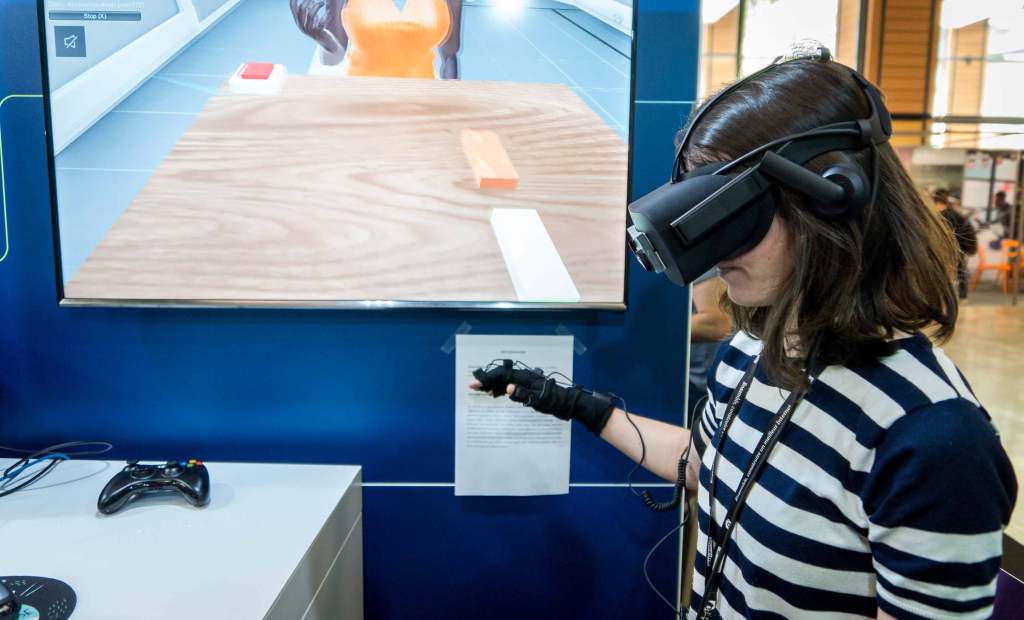
Advances in emerging media are swiftly reshaping the landscape of storytelling, at a level and pace unseen since the invention of the moving image. Emerging media is already generating story forms that re-invent the way we experience narratives. With such disruption of existing moving image practices comes an opportunity to contribute to a new generation of narrative approaches that reflect the full plurality of the human experience.
To chart a course through this new terrain, over the past two years JustFilms has been making some exploratory grants to better understand the landscape of creativity and free expression in emerging media. An emerging media summit held at the Ford Foundation this week will bring together foundations and donors to discuss what we’ve learned from this work, including a comprehensive landscape analysis by Kamal Sinclair called Making A New Reality.
JustFilms supports creative moving image storytellers and the organizations and networks that enable their work. Our exploratory funding over the past two years has focused on three integrated components:
- Research into and analysis of new forms in emerging media, their economies, structures and blind spots, and recommendations for interventions by social justice philanthropy
- Access to experimentation for artists of color and socially engaged artists, enabling them to develop new frameworks, languages and agendas for the present and future of tech-enabled storytelling
- Content funding for immersive story experiments rooted in and/or co-created by community members adversely impacted by inequality.
So why is now the right time for social justice philanthropy to engage with emerging media? The field is young, and access to tools for diverse creators is extremely limited. Adoption rates for users are projected to soar. And emerging media will be a site of convergence for all of Ford’s Creativity and Free Expression fields: moving image forms, journalism, and the arts.
Emerging media in its infancy
With the evolution of the digital age comes a new frontier of immersive expression—one that is already proving potent in ways people haven’t experienced before, according to research at Stanford University Virtual Human Interaction Lab. The development of its grammar, aesthetics and its business models are still forming. Emerging media is a distinct field of image-based practice where cinema, journalism, sculpture, performance, visual arts, radio, music, and theater all provide inspiration. It includes immersive media, such as virtual reality, augmented reality, 360-degree storytelling, and hyper-reality. I think of it as tech-enabled storytelling. Coding serves as its architecture. While the experience of virtual reality (VR) or augmented reality (AR) is still clunky, inelegant and messy— hallmarks of its emergent status—the short-form experiences being created today are experiments in search of the theory and practice that will be the architecture for future forms of visual storytelling.
Coming from a background in independent media and the arts, this moment strikes me as one akin to the early years of the independent media movement in America, when portable video technology catalyzed new story forms (video art, reality TV, video journalism) and created new audiences. Its affordability and accessibility democratized access to the means of production. Out of this grew a dynamic independent media field that wielded powerful critiques of a corporate media system organized around marketplace incentives, and that saw viewers primarily as consumers. Independent documentary was especially rooted in critiquing power structures, validating underrepresented perspectives, exposing abuse, corruption, and exploitation and offering solutions to entrenched challenges.
The decades of extraordinary documentaries and media initiatives that followed tell a story of this country’s struggles against injustice and exclusion. From Fred Wiseman’s 50-year project of documenting American institutions, to the Eyes on the Prize series — which ushered in an era of television histories from more inclusive points of view — independent media has redefined the American experience for generations. Now we are in yet another golden age of documentary artistry, shown on public media and cable, Netflix and Amazon, with a treasure trove of films and episodic documentary linked to broader efforts to build complex representations of contemporary reality.
But for all this success in creating a vital source of narratives that ran counter to those developed for commercial and other powerful interests, independent media’s Achilles heel was, and still is, its lack of diversity in voice, story, and leadership. Transforming this status quo in film, arts, and journalism is a central tenet of the work of Creativity and Free Expression at Ford—because emerging media is exhibiting the same patterns of lack of inclusion and diversity. We believe that today, philanthropy can provide the crucial funding and support that will make it possible for this burgeoning creative field to be more inclusive and diverse.
Envisioning the potential of immersive media
Immersive media engages all human senses, essentially comprising an alternative experience of reality in a digitally coded environment. We don’t have a full understanding of how the mind and body process emerging media experiences yet, but early research points to powerful stimulation effects in the brains of people experiencing immersive media, particularly VR. This research has been convincing enough to attract people and organizations interested in telling stories about pressing contemporary issues, like forced migration, discrimination, and climate change. In a short amount of time, VR has begun to seem capable of enabling viewers to “enter” new environments and simulate the experience of “being there”—with the idea that, thus situated, they will be able to identify better with the realities of other people. The promise of VR is that it will create a feeling of connectedness, and with it, elicit the kind of empathy and compassion that inform action. The danger of VR is that rather than fostering empathy, its immersive power will create greater apathy, distraction, and fear.
Making A New Reality, a report by Kamal Sinclair (a leading emerging media expert and director of Sundance Institute’s New Frontier Lab Programs) compellingly maps the landscape of emerging media. It’s an unparalleled resource, culled from more than 100 interviews and research across the field. In it, Sinclair also looks at the impact of artificial intelligence, ambient data, wired environments, and biomedia in the storytelling landscape.
Sinclair’s report affirms that this is a prime moment for deeper investment. “It is imperative that we engineer robust participation of people from a broad set of communities, identity groups, value systems, and fields of knowledge in this emerging media landscape, in all roles and levels of power,” she writes. “This will help to mitigate the pitfalls of disruption and potentially usher in a change that has justice and equity as core values.”
So how can structural inequities be addressed earlier in the immersive story industry and its spaces of experimentation? What are the changes we must strive for in the business model itself, to attain greater equity and inclusion in decision-making? If our efforts are aimed at greater justice, what are the most fruitful artist-centered strategies for transforming unjust conditions?
A moment for investment
In this moment just before mass audiences adopt new storytelling technologies, it is crucial for more people to have opportunities develop these kinds of stories. This is essential to the development of the aesthetic language itself, and will also help fuel a more inclusive and equitable critical discourse.
With that in mind, two labs supported by JustFilms provide opportunities for artists of color to experiment with immersive storytelling and share what they’re learning with the field. In 2016, six Canadian indigenous artists joined six artists of color from the American South in the first Open Immersion Lab. Over 10 days, they generated a ground-breaking set of VR prototypes stemming from deeply discussed questions around who represents which stories from what perspective, and how the experience of the story source is honored. This partnership with the National Film Board of Canada and the Canadian Film Center will continue with writings, presentations and a further set of experimentation as a second year unfolds.
Accessibility Statement
- All videos produced by the Ford Foundation since 2020 include captions and downloadable transcripts. For videos where visuals require additional understanding, we offer audio-described versions.
- We are continuing to make videos produced prior to 2020 accessible.
- Videos from third-party sources (those not produced by the Ford Foundation) may not have captions, accessible transcripts, or audio descriptions.
- To improve accessibility beyond our site, we’ve created a free video accessibility WordPress plug-in.
Electric South | New Dimension, which takes place outside of Capetown, South Africa, is taking a different tack. In 2017, ten African artists joined a set of mentors to conceptualize VR projects that break the boundaries of conventional VR practice. Coming from fashion, sculpture, journalism, film and poetry, these creators were invited to experiment with radically re-centered approaches rooted in celebrations of reimagined worlds and the power of radical imaginaries, as well as drawing from experiences of exclusion and injustice. The sketches that emerged ranged from Afro-futuristic to poetry-infused experiences to game-based immersion. The 2018 Lab will take the same approach.
For content funding, the Emmy-Award winning VR Collisions, by Lynette Wallworth, and Unrest, by Jennifer Brea, use VR less to disseminate information-based stories than as a site where the imaginary and the psychological meet the real world, in journeys across time and space. As Wallworth, who premiered the JustFilms-supported Awavena at Sundance 2018 and at Davos 2018, says of VR, “The technologies are not superior, they are adequate vessels to hold the seed of complex world views, synthesized into a digital drama, as a real attempt at connection, illumination, and in the hope of effecting real world change.”
Continuing to combine research with practice, the results of MIT’s Open Documentary Lab’s deep dive into co-creation and its implications for community-based storytelling in both traditional and immersive practices will be the subject of a convening and report later this year. Authors Katerina Cizek, William Uricchio and Sarah Wolozin have so far conducted more than 40 interviews and in the process developed a taxonomy of co-creation, spanning from community-centered co-creation to humans with machine learning and biotech hybrids. The report will provide case studies of initiatives such as the Detroit Narrative Agency, another effort supported by JustFilms, as it examines the emerging arena at the nexus of film/narrative, community co-creation, civic strengthening, and the human-machine interface.
Furthering inclusion, creativity, and experimentation
The Ford Foundation is just one funder exploring this arena from a social justice perspective: the Knight Foundation and MacArthur Foundation are also actively supporting research and initiatives in emerging media fields. Community-based foundations and local funders also have a chance to bring these groundbreaking experiences to their own backyards. Supporting scholars, publications and others who are tracking emerging media can also make clear not just the potential of these technologies, but the dangers: How they are used for repression, surveillance, or propaganda, and how we risk losing privacy and control over our own data and networks.
Traditional narrative practice, like documentary, has long been aligned with grassroots movements. So, while emerging media may seem elite and abstract right now, these new forms are quickly being mainstreamed. We’re excited about their potential to raise awareness in ways that bring more resources to bear on urgent issues, and to catalyze change on the ground.
